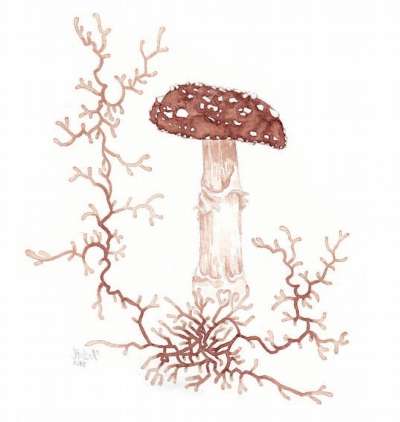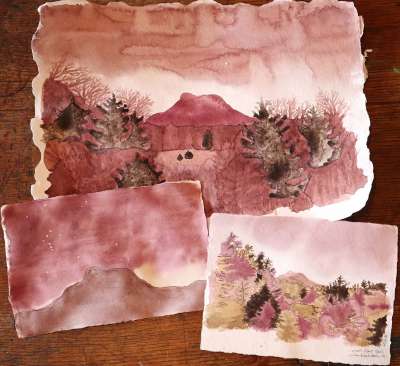It’s a warm day at a local climbing crag where I’m teaching middle schoolers nature journaling between ascents. Today’s students are interested in foraging. I pick up a crunchy piece of lichen that fell from the cliff above. “Technically these are edible,” I say, “but not delicious. They can also be used to make purple.” A boy stares skeptically at the brown scrap in my hand. “That makes purple??” Yes, despite their humble appearance, some lichens can produce vibrant colors.
People have used lichens throughout history to dye fibers, often for clothes. Many places host common lichens that produce brilliant purples, burgundies, and maroons. In ancient Europe, Roccella tinctoria was used as an alternative to the “Tyrian purple” shellfish dye. Analyses of the Book of Kells have identified lichen compounds as the pigment the medieval artists used for purple. In the mid-1700s the “cudbear” dye from Scotland used crab’s eye lichen (Ochrolechia tartarea) to make a red-purple color before overharvesting collapsed the industry.
The red-purple hue of lichen dyes is from a group of very similar organic molecules collectively called orcein. Lichens don’t produce orcein directly, they make chemical compounds called depsides and depsidones. When these compounds break down, they produce the small, colorless molecule orcinol. In the presence of oxygen and ammonia, orcinol can convert into orcein, a useable dye.
Regionally there are two lichens that are excellent sources for making orcein: smooth rock tripe (Umbilicaria mammulata) and toadskin (Lasallia papulosa). Lichens are slow-growing, so when I make dye, I never harvest them. Instead, I seek pieces that have broken off or came loose. Both smooth rock tripe and toadskin grow prolifically on vertical rock surfaces, including rock-climbing crags where they are routinely scraped away by climbers. I walk along the bottom of these cliffs and pick up as many discarded lichens as I need.
Following established dye methods, I break the lichens into small pieces and put them in glass quart jars. The reaction that produces orcein requires oxygen, so I leave a lot of head space, aiming for a less-than-half-full jar. I add enough ammonia to cover the pieces, keeping track of the volume. Historically, dyers used human urine, but plain household ammonia is a hygienic modern alternative. I let everything soak without a lid (somewhere well ventilated), swirling frequently over three days. When the mixture is thoroughly aerated, I dilute it with twice as much water as the original ammonia volume.
For three months I shake the jar regularly, venting the top, to keep oxygen levels high. If all is going well, purple hues are apparent in the first few days, but they won’t reach full intensity for months. Rock tripe tends to provide a burgundy color, while the toadskin produces a grape-juice purple. Once I’ve finished a batch of orcein lichen ink, the art begins!
I experiment with my lichen inks as-is. They are less predictable than commercial inks or watercolors, responding unexpectedly to different papers and conditions, which is part of the fun. I favor using heavy watercolor papers but have also tested birch bark and wasp paper. I frequently combine the lichen inks with similar paint made from mushrooms to expand my color palette.
I began experimenting with lichen dyes looking for a unique way to combine art, science, and nature appreciation for a class curriculum. Initially I saw the lichens as merely ingredients, but as I worked with them, I became fascinated with the organisms themselves. I’ve only begun exploring the artistic potential of making my own lichen inks, but the possibilities are as endless as the human ingenuity that first found purple in a scrap of brown lichen.




Discussion *